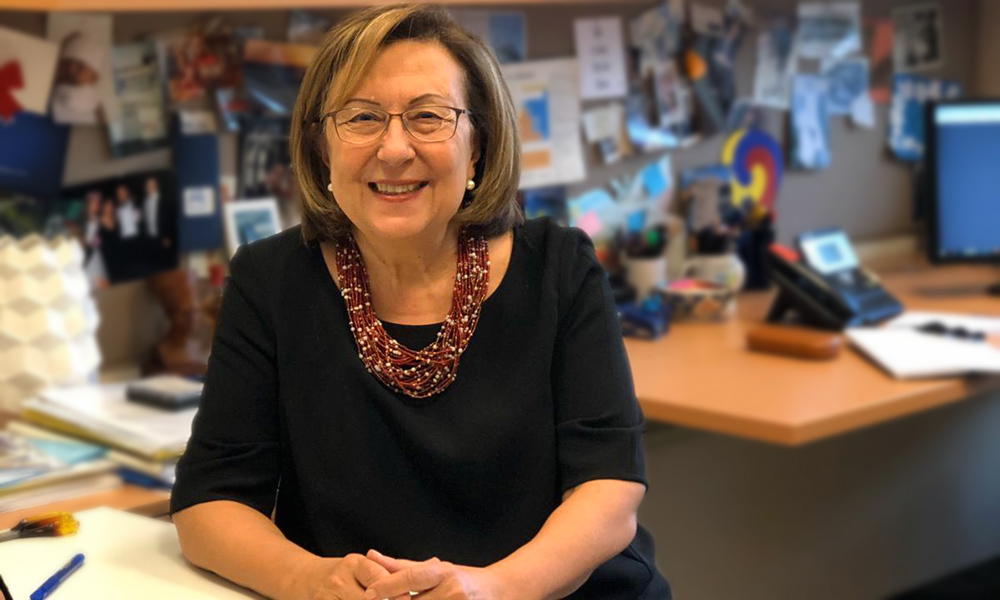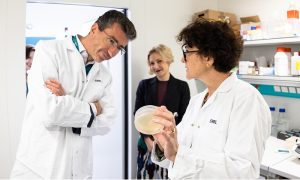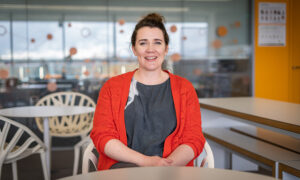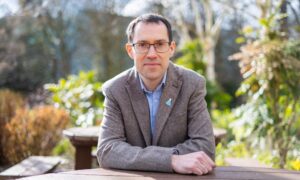
After the lecture: Zehra Sayers
An EMBL alumna shines a light on the unique capabilities and collaborative opportunities of a synchrotron in the Middle East

EMBL alumna Zehra Sayers has been the Chair of the Scientific Advisory Committee of SESAME (Synchrotron-light for Experimental Science and Applications in the Middle East) for more than 15 years.
A kind of particle accelerator, synchrotrons like SESAME provide a circular track for charged particles. Branching off from this track are straight sections called beamlines, where X-rays produced by the circulating particles are used to probe objects and learn more about them. A synchrotron can have multiple beamlines for very different kinds of experiments, for example analysing samples from archaeology, materials science, pharmacology, and molecular biology, and even analysing artworks.
Zehra, a Turkish-British structural biologist, recently spoke at an EMBL Science and Society seminar about this international collaboration. SESAME brought a synchrotron to Jordan through joint efforts by Cyprus, Egypt, Iran, Israel, Jordan, Pakistan, the Palestinian Authority, and Turkey. Since it opened in 2017, upgrades and extensive training have made SESAME a third-generation synchrotron source for researchers of diverse cultural, political, and academic backgrounds. Today the synchrotron has three beamlines, with two more under construction and capacity for as many as 25. Running on renewable energy, it is the first ‘green’ accelerator in the world.
Here, Zehra explains what makes SESAME special, why we should not fear failure, and why curiosity is her biggest driver.
I came to EMBL as a synchrotron user in Hamburg. Immediately I thought, “Wouldn’t it be wonderful if I could work here?” I learned a lot that I’ve used in my work with SESAME.
When I first heard about SESAME, I wasn’t interested. It was an old German synchrotron delivered to Amman. A white elephant. In Turkey, who knew how to use synchrotrons? But the plan was to upgrade it, and SESAME’s organisers started training programmes in the Middle East even before the synchrotron was built. In the year 2000, we were having user meetings when we still didn’t have anything to use.
Two people had been sending me emails. They’d even pressured my boss so I would get involved in SESAME. Over a dinner, I became converted. And, you know, converts are the strongest believers.
You always set your expectations very high. But it has to be that way. I was hoping for more operational beamlines, but with two more coming it sort of meets my expectations. I’m still looking for SESAME to expand more in my own field, molecular biology. Mind you, we just had measurements on our first samples at SESAME – we had put in a proposal together with colleagues from EMBL Hamburg. Although I’m sad that we couldn’t go for the experiments, I’m very happy with the results.
Small bridges are being built, especially among students. SESAME can build bridges across several cultural and political divides. Certainly it has an impact on scientists.
Very often, people think it’s simply a peace project. Of course, it’s also a peace project. But if it weren’t scientifically excellent, it wouldn’t live.
The most important thing is the science.
Scientists are curious. They get to know each other and trust each other through the language of science.
24-hour operations mean people start talking to each other. Especially the young scientists, the grad students and postdocs who are working in the middle of the night. The environment is fantastic for thinking of new collaborative projects and new ideas.
That’s the silver lining. The COVID-19 pandemic improved international collaboration – people from different parts of the world using the same platform to model coronavirus proteins is just one example. We managed to bring the scientific community closer.
Several women have inspired me, starting with my mother. She was a medic and a physiologist at Istanbul University.
I have my science heroes, like the women who are involved in CRISPR–Cas9 discoveries. I’m inspired by women who did or do things because they’re curious – driven by science. That’s inspirational. And I try to be like them.
I remember doing some experiments at home with lemon juice and how metals reacted to it when I was a kid. But my interest in science really came in middle school. I had a really good physics teacher who inspired me a lot. I wanted to have precise answers to my questions – whatever they might be.
It’s important to do something you like. For me, I like running after the things I don’t know. I feel privileged to be able to work at something where, most of the time, I’m doing things I enjoy.
Don’t be afraid of making mistakes. If you want to do something, go ahead and do it. Try to do something you like. Something for your head, chest, and belly. Those three parts should be committed to what you’re doing. Don’t be afraid of failure. You always learn something, even if it doesn’t turn out the way you planned. And don’t let anyone convince you that it’s not a good idea.
Women, on the whole, need more self-confidence. My parents always told me I could manage. They taught me to be confident. Recently, a female friend of mine told me about her staff’s annual evaluations. She recalled a male team member who came in, wasn’t particularly exceptional, and still finished the session wanting to know about the promotion he expected. None of his female counterparts asked about promotions.
My dream dinner would include both scientists and writers. I love the sea, so I’d talk to Jacques Cousteau about his experiences. I would also invite Rosalind Franklin and learn about how she felt when she saw those beautiful X-ray pictures of DNA. And the poet Pablo Neruda. I have a favourite poem from my youth that I still keep nearby, ‘Tonight I can write the saddest lines’. It’s a love poem, and it embodies passion.
EMBL Science & Society lectures are posted online following the events. You can listen to Zehra’s full talk here.


